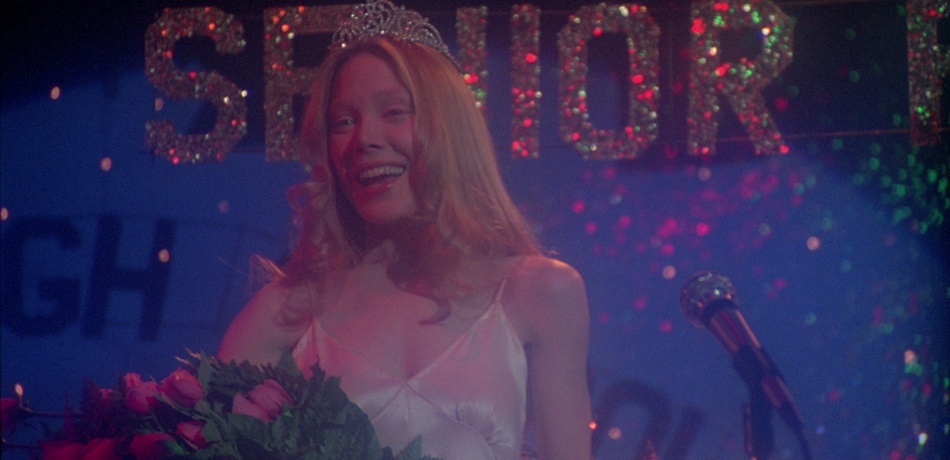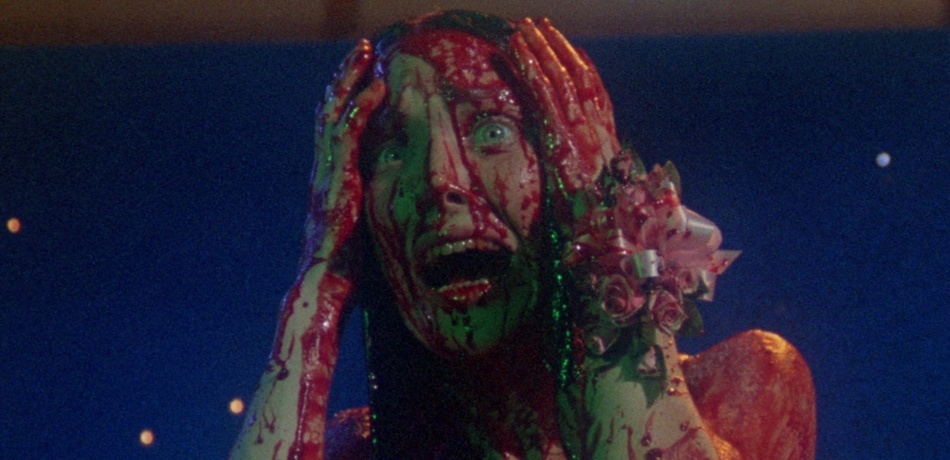CARRIE (1976)
Release Date: November 16, 1976
Synopsis (from IMDb) – “Carrie White, a shy, friendless teenage girl who is sheltered by her domineering, religious mother, unleashes her telekinetic powers after being humiliated by her classmates at her senior prom.”
Click here to buy Carrie from Amazon
Welcome to part two of A King’s Ransom. This series of articles is a look at the full Stephen King library, including re-reading all his books from the start in chronological order, as well as watching the movies that came from his incredible career – both those adapted from his novels and short stories and those original films that King had a hand in creating.
I am starting back from the beginning, but I will only deal with short stories when they arrive in collected editions. Also, for King’s movies, I am just dealing with films adapted from his novels and short stories (or his original creations) and not any sequels – so don’t expect me to watch and talk about Children of the Corn 42.
With that said, here is a look at the first ever Stephen King adaptation, also based on his first published novel, Carrie.
Carrie Movie Review (1976)
Directed by Brian De Palma
Written by Lawrence D. Cohen
Cast: Sissy Spacek, Piper Laurie, Amy Irving, William Katt, John Travolta, Nancy Allen, Betty Buckley
Stephen King wrote a few novels and a ton of short stories before he sold his first published novel, Carrie. As a matter of fact, he threw the opening to Carrie in the trash until his wife Tabitha pulled it out and demanded that he write this book. It is a good thing too. Carrie launched King’s novel writing career and also gave him his first movie credit, just two short years after publishing the book.
King’s story ended up in the hands of filmmaker Brian De Palma. While kids today may not realize how great De Palma was in his prime, a look at his filmography should convince you of his brilliance. Before Carrie, he directed the chilling thriller Sisters, and he followed up Carrie with a career that included hits like Dressed to Kill, Scarface, The Untouchables, Carlito’s Way and Mission: Impossible.
When it came to Carrie, it was easy to see that De Palma worshipped at the altar of Alfred Hitchcock – something that he made clear through homage in almost all his movies. Items that De Palma uses in Carrie that Hitchcock made famous includes the split-screen montage, the contrasting scene where two things happen at the same time, and the point of view editing where we see what that characters witness as they see it. These are great techniques to put us in the POV of characters like Carrie and Sue while raising the tension.

That is very important because so much of the novel Carrie takes place in the minds of characters like Carrie and Sue and that is something many filmmakers struggle with while adapting Stephen King movies.
De Palma’s Carrie shares many similarities with the novel, and it is clear that Brian De Palma and screenwriter Lawrence D. Cohen (who also wrote the 2013 version of Carrie) worked hard to make this movie as faithful as possible.
The film opens with a slightly disturbing scene, at least by today’s moral standards. After a volleyball game in high school PE class, the girls are all in the shower cleaning up. De Palma takes the camera slowly through the locker room, getting plenty of shots of nude girls running around with Paul Donaggio’s slightly melancholy opening title theme playing over the slow tracking shot.
The idea of the camera lecherously peeping into the girl’s locker room is disturbing enough, but then it all breaks down when Carrie starts her period and completely loses it. While the book paints the picture that Carrie believed she was dying, it is left up to the viewer to understand why she is freaking out at this moment.
Miss Collins (Miss Desjardin from the novel) slightly explains this to the principal in a scene that comes directly from the book, but it only slightly paints the picture of what is going on in Carrie’s mind. That is the one downfall of this film. De Palma uses a minimalistic approach in directing this movie when it comes to the story and tries to make up for it with his camera and editing tricks.
As a result, many of the moments in the book that shocks the reader and brings them to Carrie’s side are left unsaid in the movie. De Palma only hints at Carrie’s mother’s history of abuse and changes her father’s backstory completely. Sue plays a much smaller role in the film than she does in the book. The entire relationship between Chris and Billy barely exists. There is so much information that could make Carrie a much more sympathetic character that is missing from the movie.

The movie seems to want to show us things happening but not stick around long enough to understand why the characters do what they do. Examples are when Chris and Billy are planning the prom attack. Billy is slightly abusive and confused when dealing with Chris. They go to kill the pigs. They set up the blood. They drop the blood on Carrie. While on the run, Chris tries to run Carrie over and they die.
If that sounds like bullet points, that is how De Palma precisely edited it. That is what happened in Billy’s story. He remains nothing more than a minor side character, even though he shares responsibility for the entire massacre at the prom with Chris.
Sue is similar. She asks Tommy to take Carrie to the prom and refuses to back down when Miss Collins pushes her about it. Then, in a significant change from the novel, she goes to the dance and sees the incident before it happens only to get thrown out and spared from the death.
Once again, it sounds like bullet points, but that is how De Palma filmed it happening. The one bad thing about Sue’s story is that the movie eliminates her link with Carrie as one of the innocents that night – and someone who helped Carrie in her last moment on Earth. De Palma passed on that for the jump scare at the end.
With that said, that doesn’t mean the movie doesn’t work.

The entire setup with Carrie and her mother was well done. While the movie ignored much of her mom’s abuse, Piper Laurie did enough with her character to show how scary and demented Margaret White was. The film showed a lot of religious symbolism although De Palma chose not to point out the fundamentalism of her beliefs. Instead, he used imagery and set design to try to emphasize this fact.
When Carrie tells her mother that she is going to the prom, and her mom can’t stop her, it is the turning point in the movie – as it is in the book. That tells me that, while much was left out, what De Palma did worked well.
De Palma filmed the actual prom disaster perfectly, and the split screen and lighting choices made it work great considering the lack of gore outside of a couple of the kills. The complete devastation of the prom was not quite as massive visually in the movie, but the POV shots and split screen work made what was shown work quite well.
Another change that De Palma made was the death of Margaret White. In the book, Carrie just stopped her mom’s heart. However, in the movie, De Palma rightly understood that there needed to be a more dynamic climax, so he had Margaret stab her daughter only to have Carrie crucify her mother. The shot of Margaret pinned to the wall dead, with knives piercing her in the same spots as the small crucifix in the closet, was shocking and disturbing.

The acting was hit-and-miss. Sissy Spacek was terrific as Carrie and brought her shame, uneasiness and eventual guilt to life brilliantly. At the prom, it was easy to feel her joy, and that was all due to nothing more than the facial expressions and acting of Spacek.
Piper Laurie, as mentioned earlier, was brilliant as Margaret White. The script gave her little in the way of story, but she made up for it in her manic performance, one that created one of the most disturbing parental figures in movie history. On the other side, Betty Buckley was great as Miss Collins, delivering as the one positive authority figure in the movie.
William Katt (The Greatest American Hero) was decent as Tommy, although he was only expected to smile big most of the time. For younger actors, John Travolta, Nancy Allen and Amy Irving did the best they could with what the script gave them – Allen the best of the trio.
Carrie ended up as a very loyal and disturbing horror film. The film was, much like the book, a story of human monsters (Margaret White and Chris Hargensen) pushing an innocent girl to the limit and then watching as the world burns. In the book, Carrie was an innocent girl who becomes a monster. In the movie, Carrie kills many people but, at the end of the day, doesn’t lose her innocence.
Carrie White was a victim pushed to fight back and did it in the most brutal way possible.
Next week, I will look at the 1975 Stephen King novel Salem’s Lot.





